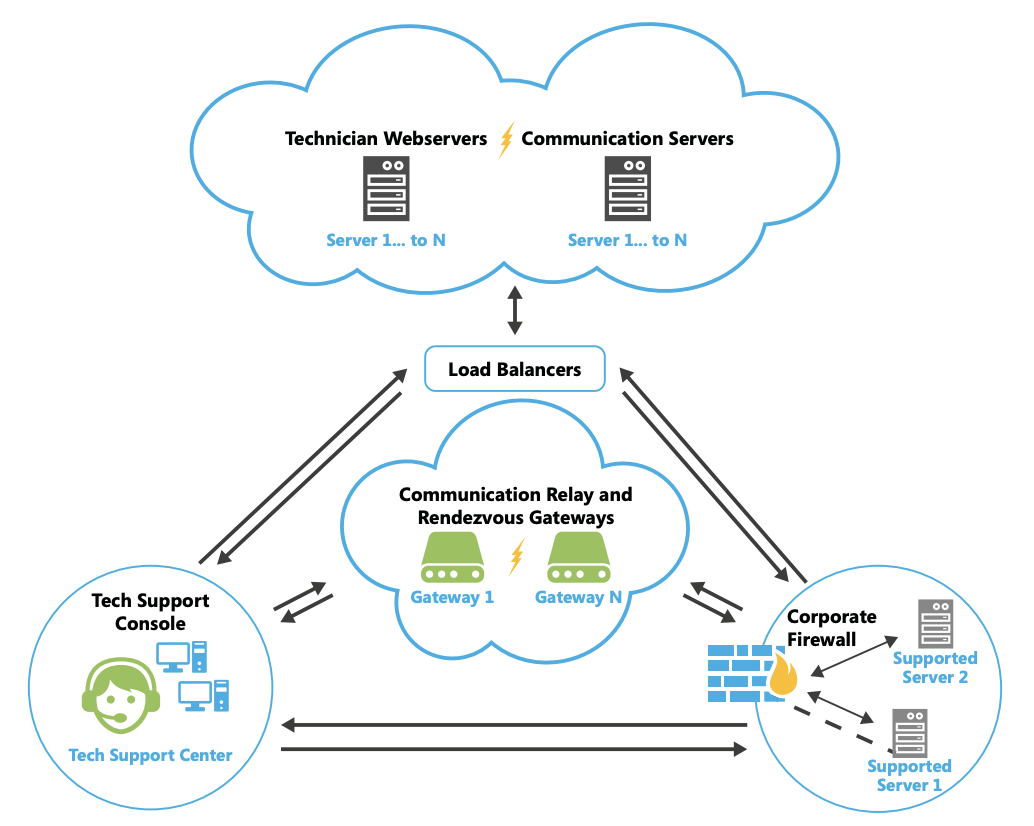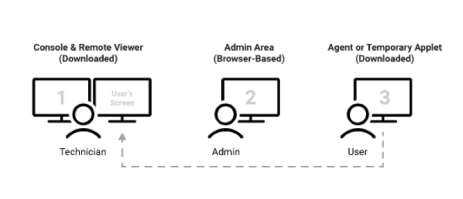Take Control Architecture Guide
Introduction
N-able's Take Control is a comprehensive and powerful remote support platform designed to provide seamless access to Windows and macOS devices from most desktop and mobile operating systems. The Take Control infrastructure is built to ensure high performance and reliability, making it an essential tool for managed service providers (MSPs) and IT professionals.
Take Control is divided into four major components: the Agent, the Viewer, the Relay, and the Web portal (Take Control (Standalone) only). The Agent is installed on the devices that need to be accessed remotely, while the Viewer is used by the technician to control these devices. The Relay Server acts as an intermediary, facilitating communication between the Agent and the Viewer. The Web Portal provides a centralized interface for managing remote sessions, user accounts, and settings.
Take Control is designed with redundancy and scalability in mind. The platform uses multiple relay servers to ensure continuous availability and load balancing, preventing any single point of failure. This redundancy ensures that remote support sessions remain stable and reliable, even during peak usage times. Additionally, the platform's modular design allows for easy integration with other N-able products and third-party tools, enhancing its functionality and adaptability.
The platform also includes features such as session recording, file transfer, and multi-monitor support, which are essential for effective remote support. These features, combined with its robust architecture, make Take Control a versatile and reliable solution for remote IT management.
Purpose and Target Audience
Purpose
The purpose of this document is to provide a comprehensive overview of the architecture of N-able Take Control. This document aims to inform Managed Service Providers (MSPs) and IT professionals about the key components, functionalities, and benefits of the N-able Take Control solution. By understanding the architecture, stakeholders can better appreciate how the solution integrates into their existing IT infrastructure, enhances remote support capabilities, and ensures secure and efficient management of client systems.
Target Audience
This document is intended for MSPs and IT professionals who are responsible for the deployment, management, and support of remote access solutions within their organizations. The target audience includes:
-
IT Managers and Directors: Individuals overseeing IT operations and strategy, who need to understand the technical capabilities and advantages of Take Control.
-
System Administrators: Professionals responsible for the day-to-day management and maintenance of IT systems, who require detailed knowledge of the solution's architecture to ensure optimal performance and security.
-
Technical Support Engineers: Personnel providing frontline support to end-users, who need to be familiar with the solution's features and troubleshooting procedures.
-
Network Engineers: Experts in network design and management, who must understand how Take Control interacts with network infrastructure to maintain connectivity and performance.
By addressing the needs and concerns of these key stakeholders, this document aims to facilitate informed decision-making and effective implementation of N-able Take Control within diverse IT environments.
Take Control High-level Architecture (Take Control at a glance)
N-able Take Control is a comprehensive and powerful, yet easy to use, remote support platform. Take Control allows access to Windows and macOS devices from most Desktop and Mobile Operating Systems, as well as iOS and Android devices for the Take Control Standalone option.
Take Control also offers a Remote Monitoring and Management module integrated into the product - Network Administrators and Managed Service Providers (MSPs) have their IT devices, whether individual or integrated into differently sized networks or topologies, reducing management costs and optimizing the implementation of policies and procedures in all types of infrastructures and organization.
The network support side of Take Control can be divided into 4 major components:
-
The Central Servers host the communication with the Tech Consoles, the Applets and the Agents, and create all incoming and outgoing sessions.
-
The Gateways keep Agents connected and distribute centralized commands, as well as mediate sessions that cannot be executed in peer-to-peer mode.
-
The Technician’s Viewers and Consoles establish connection with the clients’ devices.
-
The Agents and Applets, executed locally on the clients’ devices, allow both remote access and management.
The Central Servers establish communication with all components in different stages of the service, while the remaining servers work.
Infrastructure
Take Control’s infrastructure is built on a failure tolerant, geographically distributed and redundant architecture. It is monitored 24/7 through both automated and human resources (dedicated support contacts).
Gateways
The assignment of communication gateways is made according to country and geographic proximity. These gateways assure the successful and secure establishment of remote support sessions when there is no direct connection between the two points, or between Take Control ’s Agents.
Any gateway can be automatically replaced by an alternative connected gateway, if it is unavailable. Each one of the available gateways has several thousands of simultaneous connections, monitored in real-time for health and capacity, both by automatic systems and by Take Control ’s 24/7 Network Operations Control center. New gateways can be automatically created in a matter of minutes, if needed.
Central Servers
Take Control’s Central Servers are in three different and redundant locations hosted on Amazon Web Services (AWS). These servers coordinate the establishment of sessions and the connection to technicians, as well as the databases that support the system.
System Components
Take Control consists of six main components that work together to help MSP’s provide support to their customers:
-
Portal - End-users can download the portal and enter a PIN or a calling card activation code to send a support request and establish a one-time support session with a technician. This feature is only available in Take Control Standalone.
-
Tech Console - The Tech Console contains an interface from which technicians can manage incoming requests and start remote support sessions for customers. The latest console versions for both macOS and Windows are available to partners in the Admin Area. With the Tech Console, MSP’s can help their customers from anywhere using only a computer with an internet connection.
-
Remote Viewer - The Remote Viewer The Remote Viewer runs in the background and opens to accept support requests from a customer or can also be used to access an unattended computer or device.
-
Applet - The Applet (available in Take Control (Standalone) only) is a Windows or Mac application running on the customer’s computer, but not permanently installed. If the Applet is active (open or minimized), technicians can perform all the necessary support tasks, including remote control, chatting with customers or colleagues, making VoIP (voice over IP) calls, and viewing the device’s system info during a support session.
-
Agent - Similar to the Applet, the Agent enables remote access, but it is installed as a Windows Service or a Mac Daemon. This means the application adds a remote device to your Devices list, allowing for unattended support.
-
Admin Area - The Administrative Area (Take Control (Standalone) only) allows users with admin level permissions to configure, brand, and customize Take Control to meet their business needs. This includes setting up technicians, configuring their associated access permissions, adding devices, starting attended and unattended remote support sessions, and much more.
Summary
In conclusion, N-able Take Control’s robust architecture illustrates Take Control’s capabilities to ensure scalability, security, and operational efficiency to optimize workload distribution, enhance disaster recovery, and support business continuity. Take Control’s architecture provides a flexible, resilient, and cost-effective foundation for MSPs operations, utilizing the latest technologies and industry best practices, and safeguarding the sensitive data. The Take Control architecture’s key components have been optimized for expandability and resilience to ensure that Take Control can handle enhanced traffic and data volume without compromising on performance.


